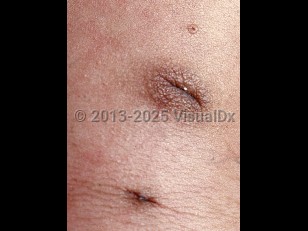Supernumerary nipple in Adult
Alerts and Notices
Important News & Links
Synopsis

Supernumerary nipples (SNs) are common congenital malformations in which additional nipples or related tissue (see accessory breast tissue) occurs along the embryonic milk line. In humans, this line extends bilaterally from a point on the inner arm just beyond the axilla, down the chest, abdomen, and groin, ending on the proximal inner thigh area. Ectopic supernumerary nipples (5%) are found beyond this milk line.
These benign lesions occur in 1%-6% of the population worldwide, and 10% of cases are familial with an autosomal dominance inheritance pattern. Incidence has been reported as more common in males (7:1 male-to-female ratio). Most are single lesions below the regular nipple but may be multiple and bilateral.
SNs are often undetected at birth and are generally without symptoms. Some become more noticeable at adolescence, menstruation, or pregnancy when increased pigmentation, fluctuating swelling and tenderness, or lactation may be noted.
There are some studies that suggest an association between accessory breast tissue, including SNs, and renal anomalies. An increased incidence of ipsilateral Becker nevus has been noted. SNs are found in several multiple congenital anomaly syndromes, including Simpson-Golabi-Behmel (overgrowth, coarse face, embryonal tumors, and congenital cardiac, renal, and/or skeletal abnormalities), cleft lip or palate ectodermal dysplasia, and tricho-odonto-onychial dysplasia. Ectopic glandular breast tissue can develop any of the lesions of normal breast tissue, including malignancy.
These benign lesions occur in 1%-6% of the population worldwide, and 10% of cases are familial with an autosomal dominance inheritance pattern. Incidence has been reported as more common in males (7:1 male-to-female ratio). Most are single lesions below the regular nipple but may be multiple and bilateral.
SNs are often undetected at birth and are generally without symptoms. Some become more noticeable at adolescence, menstruation, or pregnancy when increased pigmentation, fluctuating swelling and tenderness, or lactation may be noted.
There are some studies that suggest an association between accessory breast tissue, including SNs, and renal anomalies. An increased incidence of ipsilateral Becker nevus has been noted. SNs are found in several multiple congenital anomaly syndromes, including Simpson-Golabi-Behmel (overgrowth, coarse face, embryonal tumors, and congenital cardiac, renal, and/or skeletal abnormalities), cleft lip or palate ectodermal dysplasia, and tricho-odonto-onychial dysplasia. Ectopic glandular breast tissue can develop any of the lesions of normal breast tissue, including malignancy.
Codes
ICD10CM:
Q83.3 – Accessory nipple
SNOMEDCT:
50956007 – Supernumerary nipple
Q83.3 – Accessory nipple
SNOMEDCT:
50956007 – Supernumerary nipple
Look For
Subscription Required
Diagnostic Pearls
Subscription Required
Differential Diagnosis & Pitfalls

To perform a comparison, select diagnoses from the classic differential
Subscription Required
Best Tests
Subscription Required
Management Pearls
Subscription Required
Therapy
Subscription Required
References
Subscription Required
Last Reviewed:12/19/2021
Last Updated:12/20/2021
Last Updated:12/20/2021
 Patient Information for Supernumerary nipple in Adult
Patient Information for Supernumerary nipple in Adult
Premium Feature
VisualDx Patient Handouts
Available in the Elite package
- Improve treatment compliance
- Reduce after-hours questions
- Increase patient engagement and satisfaction
- Written in clear, easy-to-understand language. No confusing jargon.
- Available in English and Spanish
- Print out or email directly to your patient
Upgrade Today

Supernumerary nipple in Adult

